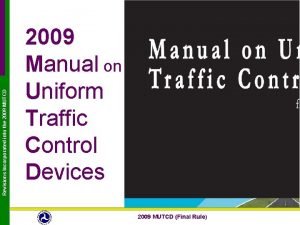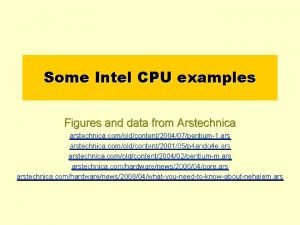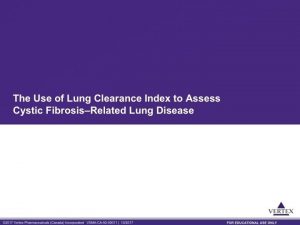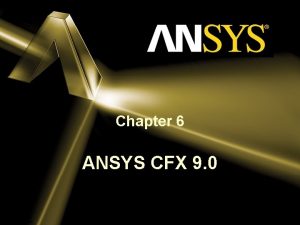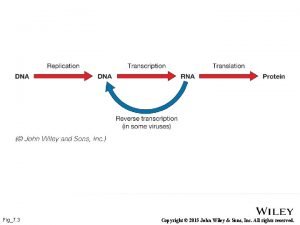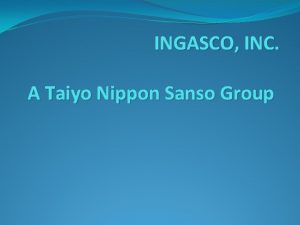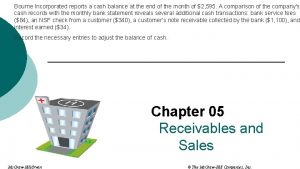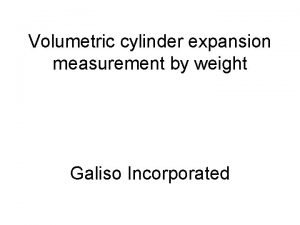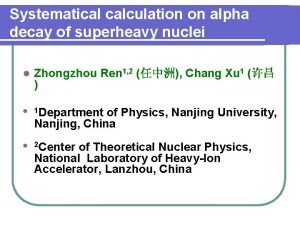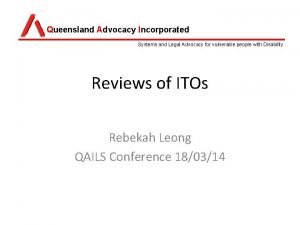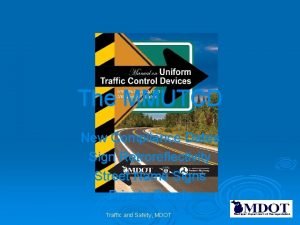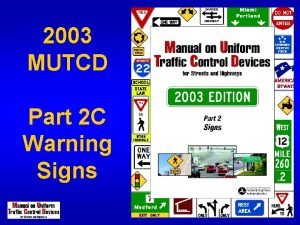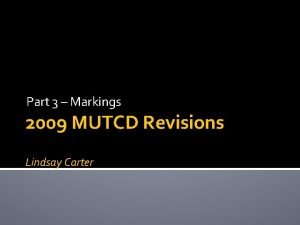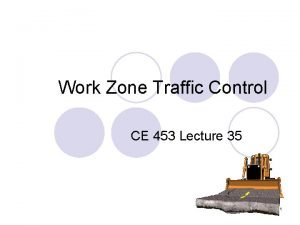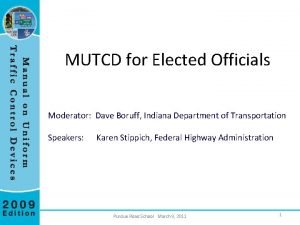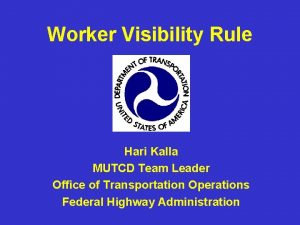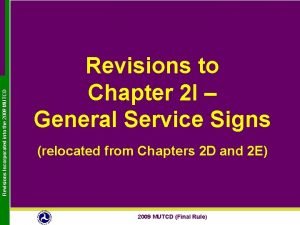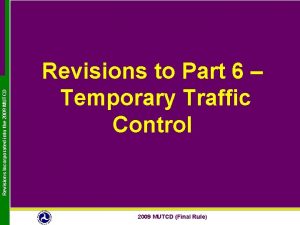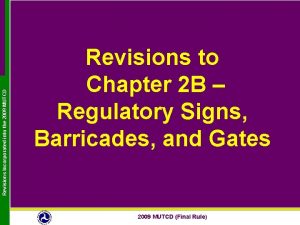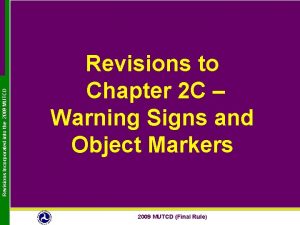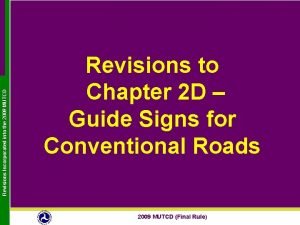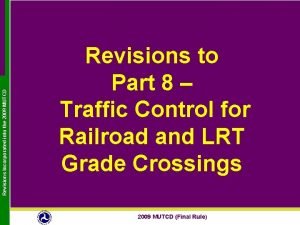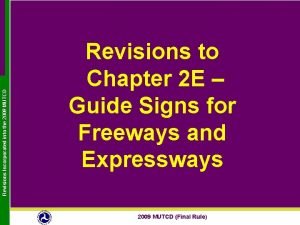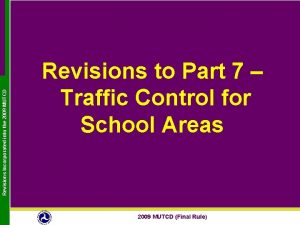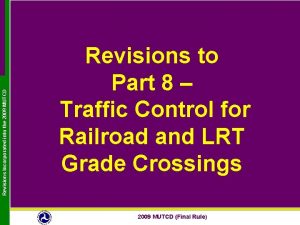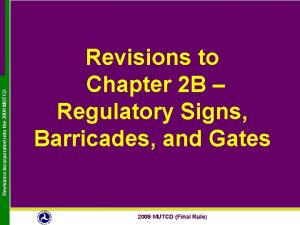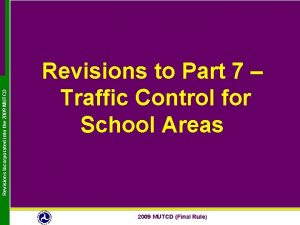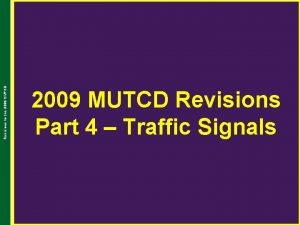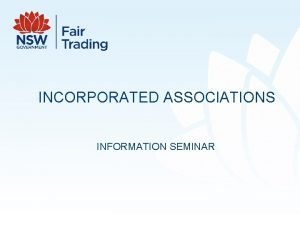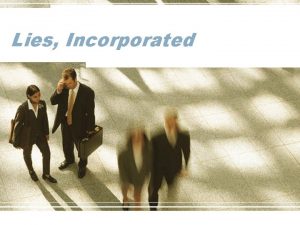2009 Manual Revisions Incorporated into the 2009 MUTCD



















- Slides: 19

2009 Manual Revisions Incorporated into the 2009 MUTCD on Uniform Traffic Control Devices 2009 MUTCD (Final Rule)

Revisions Incorporated into the 2009 MUTCD • Traffic control devices are critical for the safe and efficient transportation of people and goods. • The MUTCD, sets minimum standards and provides guidance to ensures uniformity across the nation. 2009 MUTCD (Final Rule)

Revisions Incorporated into the 2009 MUTCD • Standard—a statement of required, mandatory, or specifically prohibitive practice regarding a traffic control device. (“Shall” Statements) • Guidance—a statement of recommended, but not mandatory, practice in typical situations, with deviations allowed. (“Should” Statements) • Option—a statement of practice that is a permissive condition and carries no requirement or recommendation. (“May” Statements) • Support— an informational statement that does not convey any degree of mandate, recommendation, authorization, prohibition, or enforceable condition. 2009 MUTCD (Final Rule)

Revisions Incorporated into the 2009 MUTCD applies to all roads that are “open to public travel” Toll roads and roads within shopping centers, airports, sports arenas, theme parks, and similar business or recreation facilities that are privately owned, but the public is allowed to travel without access restrictions 2009 MUTCD (Final Rule)

• Part 1 – General • Part 2 – Signs • Part 3 – Markings Revisions Incorporated into the 2009 MUTCD • Part 4 – Signals • Part 5 – Low Volume Roads • Part 6 – Temp. Traffic Control • Part 7 – School Areas • Part 8 – RR/Transit Crossings • Part 9 – Bicycle Facilities 2009 MUTCD (Final Rule)

Revisions Incorporated into the 2009 MUTCD Part 6 Temporary Traffic Control 2009 MUTCD (Final Rule)

Revisions Incorporated into the 2009 MUTCD Temporary Traffic Control • The needs and control of all road users through a TTC zone shall be an essential part of highway construction, utility work, maintenance operations, and the management of traffic incidents. 2009 MUTCD (Final Rule)

Workers Safety Revisions Incorporated into the 2009 MUTCD Key elements of worker safety and TTC management that should be considered to improve worker safety: • All workers should be trained on how to work next to motor vehicle traffic in a way that minimizes their vulnerability. • Workers having specific TTC responsibilities should be trained in TTC techniques, device usage, and placement. 2009 MUTCD (Final Rule)

Revisions Incorporated into the 2009 MUTCD Workers Safety • All workers, within the right-of-way who are exposed to traffic within the TTC zone shall wear high-visibility safety apparel. • Firefighters or other emergency responders that directly expose them to flame, fire, heat, and/or hazardous materials may wear retroreflective turn-out gear. 2009 MUTCD (Final Rule)

Control of Traffic Revisions Incorporated into the 2009 MUTCD • The National Incident Management System requires the use of the Incident Command System at traffic incident management scenes. • Traffic incidents can be divided into three general classes of duration: – Major—expected duration of more than 2 hours, – Intermediate—expected duration of 30 minutes to 2 hours, – Minor—expected duration under 30 minutes. 2009 MUTCD (Final Rule)

Revisions Incorporated into the 2009 MUTCD Control of Traffic The primary functions of TTC • Inform road users of the incident and to provide guidance information on the path to follow through the incident area. • Alert road users and establish a well defined path to guide road users through the incident area will: – Protect the incident responders and those involved in working at the incident scene, – Aid in moving road users expeditiously past or around the traffic incident, – Reduce the likelihood of secondary traffic crashes, – Preclude unnecessary use of the surrounding local road system 2009 MUTCD (Final Rule)

Control of Traffic Revisions Incorporated into the 2009 MUTCD • Responders should mutually plan for occurrences of traffic incidents along the major and heavily traveled highways. • On-scene responders should take measures to move the incident off the traveled roadway or to provide for appropriate warning. • Emergency vehicles should be safely positioned such that traffic flow through the incident scene is optimized. • Responders should estimate the magnitude, the expected time duration, the expected vehicle queue length, and then should set up the appropriate temporary traffic controls. 2009 MUTCD (Final Rule)

Major Traffic Incidents Revisions Incorporated into the 2009 MUTCD • Major traffic incidents are typically traffic incidents involving hazardous materials, fatal traffic crashes involving numerous vehicles, and other natural or man-made disasters. • These traffic incidents typically involve closing all or part of a roadway facility for a period exceeding 2 hours. • If the traffic incident is anticipated to last more than 24 hours, applicable procedures and devices set forth in other Chapters of Part 6 should be used. 2009 MUTCD (Final Rule)

Intermediate Traffic Incidents Revisions Incorporated into the 2009 MUTCD • Typically affect travel lanes for a time period of 30 minutes to 2 hours, and usually require traffic control on the scene to divert road users past the blockage. • Full roadway closures might be needed for short periods during traffic incident clearance to allow traffic incident responders to accomplish their tasks. 2009 MUTCD (Final Rule)

Major/Intermediate Revisions Incorporated into the 2009 MUTCD • All traffic control devices needed should be available so that they can be readily deployed for all major traffic incidents. • The TTC should include the proper traffic diversions, tapered lane closures, and upstream warning devices to alert traffic approaching the queue and to encourage early diversion to an appropriate alternative route. • Attention should be paid to the upstream end of the traffic queue such that warning is given to road users approaching the back of the queue. • If manual traffic control is needed, it should be provided by qualified flaggers or uniformed law enforcement officers. 2009 MUTCD (Final Rule)

Minor Traffic Incidents Revisions Incorporated into the 2009 MUTCD • Disabled vehicles and minor crashes that result in lane closures of less than 30 minutes. • Diversion of traffic into other lanes is often not needed or is needed only briefly. • It is not generally possible or practical to set up a lane closure with traffic control devices for a minor traffic incident. • Traffic control is the responsibility of on-scene responders. • When a minor traffic incident blocks a travel lane, it should be removed from that lane to the shoulder as quickly as possible. 2009 MUTCD (Final Rule)

Emergency-Vehicle Lighting Revisions Incorporated into the 2009 MUTCD • The use of emergency-vehicle lighting is essential, especially in the initial stages of a traffic incident, • Emergency-vehicle lighting, however, provides warning only and provides no effective traffic control. • The use of too many lights at an incident scene can be distracting and can create confusion for approaching road users, especially at night. • Road users approaching the traffic incident from the opposite direction on a divided facility are often distracted by emergencyvehicle lighting and slow their vehicles to look at the traffic incident posing a hazard to themselves and others traveling in their direction. 2009 MUTCD (Final Rule)

Revisions Incorporated into the 2009 MUTCD Emergency-Vehicle Lighting • Public safety agencies should examine their policies with the intent of reducing the use of this lighting as much as possible while not endangering those at the scene. • Special consideration should be given to reducing or extinguishing forward facing emergency-vehicle lighting to reduce distractions to oncoming road users. • Any floodlights or vehicle headlights that are not needed for illumination, or to provide notice to other road users of an incident response vehicle being in an unexpected location, should be turned off at night. 2009 MUTCD (Final Rule)

Revisions Incorporated into the 2009 MUTCD For More Information http: //mutcd. fhwa. dot. gov/ 2009 MUTCD (Final Rule)
 Mutcd 2009 edition
Mutcd 2009 edition Which function is incorporated into some intel cpus
Which function is incorporated into some intel cpus Vertex pharmaceuticals (canada) incorporated
Vertex pharmaceuticals (canada) incorporated Virtual topology ansys workbench
Virtual topology ansys workbench John wiley & sons, incorporated
John wiley & sons, incorporated Ingasco incorporated
Ingasco incorporated Bourne incorporated reports a cash balance
Bourne incorporated reports a cash balance Galiso
Galiso Ddcm incorporated
Ddcm incorporated Unincorporated vs incorporated business
Unincorporated vs incorporated business Infinite energy incorporated srl
Infinite energy incorporated srl Queensland advocacy incorporated
Queensland advocacy incorporated Mutcd
Mutcd Mutcd warning signs
Mutcd warning signs Mutcd chapter 2
Mutcd chapter 2 Mutcd
Mutcd Lindsay carter
Lindsay carter Termination area mutcd
Termination area mutcd Indiana highway
Indiana highway Hari kalla
Hari kalla
